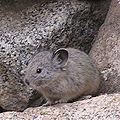Pika
| Pika |
|---|

|
| Scientific Classification |
|
| Subgenera and Species |
|
Subgenus: name
|
The Genus Ochotona, or pika, is a genus of small, defenseless animals that live in groups up in rocky or mountainous terrains. The average pika is expected to live about three years depending on the species and the area. They are closely related to rabbits and hares and are in the lagomorph order. Although the pikas live in groups or communities and warn each other of predators there is constant stealing from each other. The pikas unfortunately are completely defenseless in the open which makes them easy targets for starving predators. The way they compensate is through lots of breeding and spending months at a time in their caves, only traveling out to gather vegetation for nutrition. The pika is an animal that is mostly a slot in the food chain. Pikas do not effect their environment other then feeding the food chain and the vegetation they forage for.
Anatomy
Pika's are small furry animals that have short stubby limbs and only some have tails. The Pika's head has rounded ears and an average rodent face. Their stomachs can only retain a certain amount of nutrients at one time. To solve this the pika digests its food excretes it then eats it again to get all the nutrients. Pikas live in rocky terrains high in the mountains so they have a thick fur coat and live in caves. The pika has a common mouth for a herbivore with two large incisors, no canine teeth and few molars. Pika's have a vocal system that allows them to bark very loudly to alert the other pikas of predators.
Reproduction
Pikas reproduce sexually and typically have two litters a year. Each with less than 5 young but are able to give birth at least once year. Normally they start to breed in the spring and have one liter then will meet again to attempt at a second liter before summer's end. Pikas are maternal and raise their young in the summer. Some are able to give birth to up to 12 offspring on average. Although hunted regularly the pikas population is balanced by the reproduction methods and their underground homes. Pika genders do not live together and rarely visit except to mate.
Ecology
Pikas are herbivores with no carnivore characteristics whatsoever. The common pika will often stay within the vicinity of its home when hunting for any and all kinds of plant material that it can find. Being four-legged and having such small and weak limbs the pika will not pick up the plant but cut it off at the stem and carry it back like a dog fetching a stick. Pikas do not hibernate and they live in mostly rocky or mountainous areas which provide ideal homes and protection from predators. Pikas used to live in Europe and most of Asia but are mostly extinct from those areas now. Other pikas have been spotted in Mongolia but are now mostly living in North America. Pikas are diurnal, which means mostly active during the day. Pikas are hunted by the common rodent eaters; foxes, hawks, eagles, but they are also hunted by weasels.
Media:http://www.youtube.com/watch?v=C1v3-7VjlAI
A Pikas Bark
The pika is also known as the "whistling hare" for its alarming bark. Like many animals the pika lives in a community of the same species that look out for each other. The Pika will let out a large bark to alert the rest of the animals that a predator is coming if the pika see's a threat. Although there is a mutual agreement of sorts to warn the other pikas of danger the pikas steal from each other constantly. These disputes are almost always broken up by a predator attacking the habitat of the pikas.
Gallery
References
- Pika--Calling Hare Liane Tomasetti, pocanticohills.org, Feb 3,2011.
- animals.jrank.org animals.jrank.org, net industries ,Feb 3,2011.
- Wikipedia.orgWikipedia.org, Wikepedia.org, 1 February 2011.
- department of fish and game author, publisher, date.






